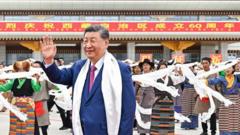In a rare appearance, President Xi Jinping addressed around 20,000 people in Tibet's capital Lhasa to commemorate 60 years since the establishment of the Tibet Autonomous Region (TAR) by the Chinese government. His remarks focused on the importance of political stability, social unity, and the need for ongoing development in the region. This visit, only the second of its kind for Xi as president, underlines his intention to assert authority in a region noted for its historical resistance to Chinese governance.
While acknowledging local government efforts to combat separatism—a reference to the long-standing tensions with Tibetan independence advocates—Xi refrained from mentioning the Dalai Lama, who has lived in exile since fleeing to India in 1959. Xi reiterated the Chinese Communist Party's stance that Tibetans are free to practice their faith but noted the necessity of adapting religious practices to align with socialist principles.
The timing of Xi's visit is significant, coinciding with a recent statement from the Dalai Lama's office claiming authority over the selection of his successor—an assertion disputed by Chinese authorities who claim it solely rests with them. Human rights organizations have long criticized Beijing for its treatment of Tibetans, emphasizing the erosion of cultural identity and freedoms, even as Beijing highlights improved living standards in the region.
Photos of Xi’s visit adorned the front pages of state media on Thursday, celebrating his interactions with local cultural displays and crowds. Xi's agenda included discussions with local officials about enhancing economic, cultural, and personnel exchanges within the region.
Central to his vision for Tibet, Xi outlined four strategic goals: maintaining stability, promoting development, protecting the environment, and bolstering national borders. This aligns with a recent surge in infrastructure development projects, notably the massive Motuo Hydropower Station on the Yarlung Tsangpo River, which aims to become the world's largest dam. The projected costs surpass $167 billion, and while the Chinese government assures that eco-friendly practices will be followed, concerns persist regarding potential implications for water flow downstream into India and Bangladesh.
As China moves forward with the ambitious project, tensions remain palpable—signaling an ongoing struggle between local aspirations for identity and the central government’s governance strategy in the historically rich, yet politically sensitive Tibetan plateau.
















